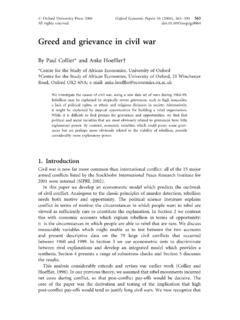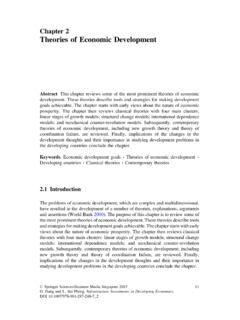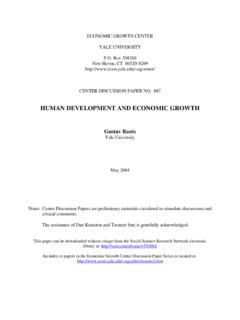Transcription of Economic Development: Overview - New York University
1 CHAPTER2 Economic development : OverviewBy the problem of Economic development I mean simplythe problem of accounting for the observed pattern, acrosscountries and across time, in levels and rates of growth ofper capita income. This may seem too narrow a definition,and perhaps it is, but thinking about income patterns willnecessarily involve us in thinking about many other aspectsof societies too, so I would suggest that we withholdjudgement on the scope of this definition until we have aclearer idea of where it leads us. R. E. Lucas [1988][W]e should never lose sight of the ultimate purpose ofthe exercise, to treat men and women as ends, to improvethe human condition, to enlarge people s choices. [A] unityof interests would exist if there were rigid links betweeneconomic production (as measured by income per head)and human development (reflected by human indicatorssuch as life expectancy or literacy, or achievements such asself-respect, not easily measured).
2 But these two sets ofindicators are not very closely related. P. P. Streeten [1994] IntroductionEconomic development is the primary objective of the majority of theworld s nations. This truth is accepted without controversy, or so itwould appear in public discourse at least. Raising the well-being andsocioeconomic capabilities of peoples everywhere is easily the most crucial18 Economic development : Overviewsocial task facing us today. Every year, aid is disbursed, investments areundertaken, policies are framed, and elaborate plans hatched to achievethis goal, or at least to get closer to it. How do we identify and trackthe results of these e orts? What criteria do we use to evaluate theextent of development a country has undergone or how developed or underdeveloped a country is at any point in time?
3 How do we measuredevelopment?The issue isn t easy to resolve. We all have intuitive notions of devel-opment. Presumably, when we speak of a developed society, we havein mind a world in which people are well fed and well clothed, haveaccess to a variety of goods and services, possess the luxury of leisure andentertainment, and live in a healthy environment. We think of a societyfree of violent discrimination, with tolerable levels of equality, where thesick receive proper medical care and people do not have to sleep on thesidewalks. In short, most of us would insist that aminimalrequirement fora developed nation is that itsphysicalquality of life be high, uniformlyso rather than restricted to an incongruously a uent course, the notion of a good society goes further.
4 We might stress politicalrights and freedoms, intellectual and cultural development , stability of thefamily, a low crime rate, social civility and so on. However, a high andwidely accessible level ofmaterialwell-being is probably a prerequisite formost other kinds of advancement, quite apart from being a worthy goal and policy makers therefore do well (and have enoughto do!) by concentrating on this aspect is, of course, tempting to suggest that the state of material well-being of anation is captured quite accurately by its per capita gross national income(GNI): the per person value of income earned by the people of a countryover a given year. (Or one might invoke its close cousin, gross domesticproduct, GDP, which restricts itself to domestically produced income, andignores net income received from other countries, such as dividends,interest or repatriated profits.)
5 Indeed, since Economic development atthe national level was adopted as a conscious goal,2there have been longphases during which development performance was judged exclusivelyby the yardstick of per capita income growth. In the last few decades,this practice increasingly has come under fire from various quarters. Thedebate goes on, as the quotations at the beginning of this chapter is not to suggest at all that it issu cientfor every kind of social most poor countries, this starting point was the period immediately following WorldWar II, when many such countries, previously under colonial rule, gained independenceand formed national development : Overview19We must be careful here. No one in their right mind would ever suggestthat Economic development be identified, in adefinitionalsense, with thelevel or growth of per capita income.
6 It is perhaps universally accepted thatdevelopment is not just about income, although income ( Economic wealth,more generally) has a great deal to do with it. For instance, we notedpreviously that Economic advancement should not be restricted to a smallminority. This means, in particular, that development is also the removal ofpoverty and undernutrition: it is an increase in life expectancy; it is accessto sanitation, clean drinking water, and health services; it is the reductionof infant mortality; it is increased access to knowledge and schooling, andliteracy in is an entire multitude of yardsticks. PaulStreeten s thoughts, summarized in the quotation at the beginning of thischapter, capture this multidimensionality very more intriguing is the sharp focus of Robert Lucas words (seequotation).
7 At first they appear narrow, perhaps even missing the point,whereas the more holistic scenario sketched in the foregoing paragraphsseems pretty much the way to go. In thinking this we would be Lucas nor any intelligent person believes that per capita incomeisdevelopment. What s hidden in these words is actually an approach, nota definition. It is really a belief about the world, which is thatthe universalfeatures of Economic development health, life expectancy, literacy, and so on follow in some natural way from the growth of per capita income, perhaps with thepassage of time. Implicit here is a belief in the power of aggregate economicforces to positively a ect every other socioeconomic outcome that we wantto associate with development .
8 This outlook may be contrasted withthe view that a correlation between per capita income and other desiredfeatures is not automatic, and that in many cases those connections maynot be present at all. According to this view, per capita income fails as anadequate overall measure and must be supplemented by other debate implicit in the two quotations is not, therefore, about whatdevelopmentmeans, on which there is possibly widespread is really about a view of the world about the possibility of finding asmaller set of variables that correlates well with the multifaceted processof development . Note well that, in a way, saying too much is saying too3 The Millenium development Goals, set out in United Nations meeting in 2000 describe sixtargets: (1) eliminate extreme poverty and hunger, (2) universalize primary education, (3)achieve gender equality, (4) reduce infant and child mortality, (5) improve maternal health,(6) combat disease, such as HIV/AIDS and malaria, (7) build a sustainable environment,and (8) develop a global partnership for development .
9 There is no reason for you to buy allof these goals; the point is only to illustrate the implicit recognition of development as amultifaceted development : Overviewlittle. It may be that per capita income does not capture all aspects ofdevelopment, but a weighty assertion that no small set of variables evercaptures the complex nature of the development process and that there arealways other considerations is not very helpful. In this sense, the view thateconomic development is ultimately fueled by per capita income may betaking things too far, but at least it has the virtue of attempting to reduce alarger set of issues to a smaller set, hopefully in a way that is supported bysound reasoning and empirical book implicitly contains a reduction as well, although not all the wayto per capita income alone.
10 In part, sheer considerations of space demandsuch a reduction. Moreover, we have to beginsomewhere, so we concentrateimplicitly on understanding two sets of connections throughout this is how averagelevelsof Economic attainment influence be sure, this must include an analysis of the forces that, in turn, causeaverage levels of income and other indicators to grow. The other connectionis how thedistributionof Economic attainment, across the citizens of a nationor a region and across the nations of the world, influences task of understanding these two broad interrelationships takes us ona long journey. In some chapters the relationships may be hidden in thedetails, but they are always there: levels and distribution as twin beaconsto guide our is not to say that the basic features of development will be them is our primary goal, but our approach to them lies throughthe two routes described in the previous begin with a summary of the historical experience of developingcountries over the past few decades.







